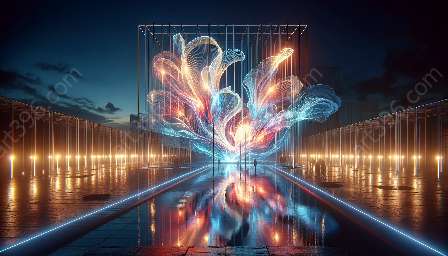Contemporary light art represents a dynamic fusion of light and visual art & design, offering a mesmerizing and immersive experience for viewers while pushing the boundaries of creativity and innovation. This topic cluster delves into the fascinating world of contemporary light art, exploring its history, techniques, and the prominent artists who have made significant contributions to this evolving art form.
The History of Light Art
Light art has a rich history that dates back to the early 20th century when artists began experimenting with light as a medium for artistic expression. The revolutionary use of artificial light, neon tubes, and other luminous elements in art installations became a defining characteristic of the movement. Notable artists such as James Turrell and Dan Flavin played pivotal roles in shaping the trajectory of light art, paving the way for future generations of artists to explore the possibilities of light in their work.
Techniques and Mediums
Contemporary light art encompasses a diverse range of techniques and mediums that artists use to create captivating installations and artworks. From projection mapping and LED technology to kinetic sculptures and interactive light installations, practitioners of light art continually push the boundaries of what is possible through innovative use of light. These techniques allow artists to transform physical spaces and captivate audiences with immersive visual experiences that challenge traditional notions of art and design.
Prominent Artists in Light Art
Several prominent artists have left an indelible mark on the world of contemporary light art through their groundbreaking work and innovative approaches. Olafur Eliasson, known for his large-scale installations that incorporate light, color, and natural elements, has redefined the relationship between art, architecture, and the environment. Other artists such as Carlos Cruz-Diez and Jenny Holzer have also made significant contributions to the field, exploring the intersection of light, technology, and social commentary in their thought-provoking artworks.
Light Art in Visual Art & Design
Through its interdisciplinary nature, contemporary light art has become an integral part of visual art & design, influencing various creative disciplines including architecture, interior design, and public art. The use of light as a primary medium allows artists and designers to transform spaces, evoke emotions, and engage with audiences in new and compelling ways. As a result, light art has become an essential component of contemporary visual art and design practices, enriching the built environment and fostering innovative approaches to artistic expression.
The Future of Light Art
The future of contemporary light art is filled with endless possibilities and potential for further exploration. As technology continues to advance, artists are empowered to experiment with new forms of light, interactivity, and immersive experiences. This opens doors for collaborations with other creative disciplines, leading to dynamic and boundary-pushing artworks that redefine the relationship between light, space, and perception. With an ever-evolving landscape, contemporary light art remains a vibrant and exciting field that continues to captivate and inspire audiences worldwide.
Topic
Sustainability and Environmental Consciousness in Light Art
View details
Psychological and Emotional Impact of Light Art
View details
Integration of Light Art with Architecture and Urban Design
View details
Cultural Diversity and Inclusivity in Light Art
View details
Artistic Interpretations of Light in Contemporary Practice
View details
Public Accessibility and Inclusivity in Light Art
View details
Innovative Materials and Techniques in Light Art
View details
Light Art and Digital Transformation of Art and Design
View details
Light Art in Public Spaces and Urban Environments
View details
Challenging Traditional Boundaries in Light Art
View details
Role of Light Art in Temporary and Permanent Installations
View details
Cultural and Historical Influences on Contemporary Light Art
View details
Questions
What are the key principles of contemporary light art?
View details
How does technology influence the creation of light art?
View details
What are the different techniques used in light art installations?
View details
How does light art challenge traditional concepts of visual perception?
View details
What are the cultural and historical influences on contemporary light art?
View details
What role does sustainability play in contemporary light art?
View details
How does light art impact public spaces and urban environments?
View details
How does light art interact with architecture and space?
View details
What psychological effects can be achieved through light art?
View details
How is light art used in storytelling and narrative?
View details
What are the ethical considerations in creating light art installations?
View details
How does light art engage with social and political issues?
View details
What are the connections between light art and environmental consciousness?
View details
How does cross-disciplinary collaboration enhance light art projects?
View details
What are the symbolic representations of light in art history and contemporary practice?
View details
How does light art redefine the boundaries of traditional art forms?
View details
What is the role of immersive experiences in light art?
View details
How does light art challenge conventional exhibition methods?
View details
What are the educational applications of light art in classroom settings?
View details
How does light art engage with the concept of time?
View details
What are the connections between light art and spirituality?
View details
How does light art contribute to the digital transformation of art and design?
View details
What are the sensory experiences created by light art installations?
View details
How does light art influence the perception of scale and dimension?
View details
What are the innovative uses of materials in contemporary light art?
View details
How does light art intersect with interactive technology?
View details
What role does light art play in the creation of temporary and permanent public art installations?
View details
How does cultural diversity influence the practice of light art?
View details
What are the economic impacts of light art on local and global art markets?
View details
How does light art contribute to the discourse on public art accessibility and inclusivity?
View details
What are the connections between light art and art therapy?
View details
How does light art engage with the concept of transformation and change?
View details

